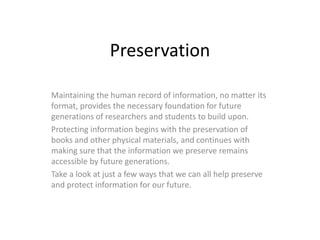
Preserving Information for Future Generations
- 1. Preservation Maintaining the human record of information, no matter its format, provides the necessary foundation for future generations of researchers and students to build upon. Protecting information begins with the preservation of books and other physical materials, and continues with making sure that the information we preserve remains accessible by future generations. Take a look at just a few ways that we can all help preserve and protect information for our future.
- 2. Book Preservation A variety of equipment and supplies are used for book preservation and repair. All supplies are pH neutral (acid-free), and intended to last as long as the volumes being mended.
- 3. Acid-free tapes, glues, and bindings are used to repair torn pages, fragile bindings, and separated covers.
- 4. A finishing press keeps the pages of repaired books together while glue dries.
- 5. Clean cotton gloves protect delicate pages from dirt as well as the natural oils found on skin.
- 6. Separated bindings are strengthened and re-adhered using acid-free tapes.
- 7. Acid-free tapes remain clear and effective over time.
- 8. Embrittled pages – those printed on acid-based paper that has deteriorated over time – may not be suitable candidates for repair at all.
- 9. Digital Transitions Data and digital media provide interesting challenges for preservation. Interoperability and compatibility must be maintained throughout the years as media formats are revised and replaced.
- 10. Films recorded on 16mm, Super-8, and other media require suitable players in order to view them.
- 11. Punch cards were first used in the 1700s in the textile weaving business, and represent one of the earliest programming methods.
- 12. LP records, VHS and Betamax tapes, and Laser video discs each require dedicated players.
- 13. Information storage media evolves over time, leaving behind former technologies – but not the need to access the information stored within them.
- 14. Acid-Free Publication Acid-free materials are crucial to the longevity of printed works. For example, a rare copy of the works of Geoffrey Chaucer, printed by John Stow in 1561, is in excellent condition despite its age.
- 15. John Stow was a London tailor, chronicler, antiquarian, ardent book collector, and copyist. This was his first publication, issued three years before William Shakespeare was born.
- 16. Notice that despite signs of wear, the acid- free paper used in this volume remains in excellent condition and shows little signs of yellowing.
- 17. Bookmarks “Use a proper bookmark to mark your place. Please don't dog-ear pages, or use sticky notes or paper clips. These items cause permanent damage to the pages of a book. Use a thin slip of paper instead.” Source: Preservation of Library Materials at Smith: Book Care & Handling Tips. http://www.smith.edu/libraries/info/preservation
- 18. The simple bookmark remains an excellent tool for protecting book spines and pages.
